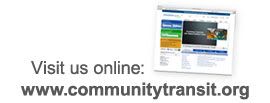Showing posts with label ballot measure. Show all posts
Showing posts with label ballot measure. Show all posts
Friday, August 7, 2015
Session in Review: How Community Transit Fared with the 2015 Legislature
The historically long (176 days) 2015 Washington State Legislative Session is now best remembered in transit circles for the transportation revenue package passed in early July. That legislation gave Community Transit authority to seek local sales tax funding for increased transit service, which will be decided by voters on November 3.
Here is a recap of legislation affecting Community Transit.
Funding for Community Transit
16-year New Transportation Revenue Package
• Local option authority – As discussed above, this granted Community Transit authority to seek up to 0.3 percent sales tax increase for transit. The Community Transit Board approved a ballot measure for the full 0.3 percent to fund more bus trips on all routes, a second Swift line and a list of other improvements. Measure will be on November 3 general election ballot.
• $10 million in flexible spending for second line of Swift. This funding, which is designated to be received in future biennia, can be used for Swift capital infrastructure (buses and stations) or operations.
2015-17 Transportation Budget Regional Mobility Grants
• Seaway Transit Center, $3 million in 2015-17 and $3.8 million in 2017-19
This transit center, located across the street from Boeing-Everett’s main gate, will serve as the northern terminal for the second Swift line, as well as a hub for all Paine Field area buses, including Community Everett and Metro Transit. Design is underway and project can be completed in 2017.
• Mukilteo Park & Ride, $3.48 million in 2015-17
This commuter park & ride will be located on Bernie Webber Drive on the west side of Paine Field, about a block off the Mukilteo Speedway. It will be primarily used for local residents catching routes to Seattle and UW. This project is awaiting final local matching funds.
Statewide Transit Funding from New Transportation Revenue Package
Gas tax revenue, the primary revenue source for this legislation, cannot be used for any transit projects. These projects are funded through other sources defined in the legislation. Community Transit may compete for some of these grants, but funding is not guaranteed.
• Special Needs Transportation Grants increased from $25 million per biennium to $60 million
• Rural Mobility Grants increased from $17 million per biennium to $30 million
• Regional Mobility Grants increased from $40 million per biennium to $75.25 million
• Vanpool Grants increased from $6 million per biennium to $9.9 million
• Transit Agency Coordination (HB 1842), $5 million over 16 years
• Transit project earmarks, $111 million over 16 years (includes above $10 million for Swift)
Here is a recap of legislation affecting Community Transit.
Funding for Community Transit
16-year New Transportation Revenue Package
• Local option authority – As discussed above, this granted Community Transit authority to seek up to 0.3 percent sales tax increase for transit. The Community Transit Board approved a ballot measure for the full 0.3 percent to fund more bus trips on all routes, a second Swift line and a list of other improvements. Measure will be on November 3 general election ballot.
• $10 million in flexible spending for second line of Swift. This funding, which is designated to be received in future biennia, can be used for Swift capital infrastructure (buses and stations) or operations.
2015-17 Transportation Budget Regional Mobility Grants
• Seaway Transit Center, $3 million in 2015-17 and $3.8 million in 2017-19
This transit center, located across the street from Boeing-Everett’s main gate, will serve as the northern terminal for the second Swift line, as well as a hub for all Paine Field area buses, including Community Everett and Metro Transit. Design is underway and project can be completed in 2017.
• Mukilteo Park & Ride, $3.48 million in 2015-17
This commuter park & ride will be located on Bernie Webber Drive on the west side of Paine Field, about a block off the Mukilteo Speedway. It will be primarily used for local residents catching routes to Seattle and UW. This project is awaiting final local matching funds.
Statewide Transit Funding from New Transportation Revenue Package
Gas tax revenue, the primary revenue source for this legislation, cannot be used for any transit projects. These projects are funded through other sources defined in the legislation. Community Transit may compete for some of these grants, but funding is not guaranteed.
• Special Needs Transportation Grants increased from $25 million per biennium to $60 million
• Rural Mobility Grants increased from $17 million per biennium to $30 million
• Regional Mobility Grants increased from $40 million per biennium to $75.25 million
• Vanpool Grants increased from $6 million per biennium to $9.9 million
• Transit Agency Coordination (HB 1842), $5 million over 16 years
• Transit project earmarks, $111 million over 16 years (includes above $10 million for Swift)
Tuesday, July 21, 2015
Community Transit Ballot Measure -- What Does It Mean?
On July 16, the Community Transit Board of Directors voted
to place a measure on the Nov. 3 general election ballot seeking an additional
0.3 percent sales tax for increased transit services.
The board resolution is not the final step. Technically, any candidate or jurisdiction in Snohomish County has until Aug. 4 to get on the November ballot. After that time, the County Auditor will release the official ballot. That should be just a formality for our measure.
What does this mean? Who gets to vote?
The state has set sales tax as Community Transit’s only local means of funding, other than fares. Currently, Community Transit’s sales tax level is 0.9 percent, which is 9 cents on a $10 purchase. The new measure would add 3 cents to that same $10 purchase.
Community Transit’s sales tax is only collected in our service district, or public transportation benefit area (PTBA). Every city in Snohomish County, except Everett in in our PTBA (see map), as are many areas of the unincorporated county
Only people who live in the PTBA are eligible to vote on this measure, but anyone who shops in the PTBA pays taxes toward Community Transit. So, all those Skagit or King County residents who shop at the Seattle Premium Outlet Mall or Alderwood Mall help to support Community Transit.
That’s why we say “Buy Local for Transit!”
Why is new funding needed?
Remember when we cut service in 2010? People asked why we were the only local agency cutting service at that time. The reality is we made the tough, but fiscally responsible decision to balance our budget when revenues fell dramatically below our expenses.
The result is that we emerged from the recession early and began adding service when other transit agencies and local cities are still considering cuts.
Current service levels do not meet the demand for transit now. Ask any commuter who has to stand for 80 minutes to Seattle, or has a bus pass them by because it is already full. Or talk to the person who misses a connection and has to wait nearly an hour for the next bus.
New funding is needed so Community Transit can meet current and future transit demand in Snohomish County.
In the past two years, job growth has picked up and more people have moved to our county, and the region. The Mill Creek-Bothell area is one of the fastest growing areas in the country right now. And, forecasts for future growth are staggering: 240,000 more people and 130,000 more jobs are expected in Snohomish County by 2040, according to the Puget Sound Regional Council.
If new funding is approved, Community Transit will provide:
The board resolution is not the final step. Technically, any candidate or jurisdiction in Snohomish County has until Aug. 4 to get on the November ballot. After that time, the County Auditor will release the official ballot. That should be just a formality for our measure.
 |
| A view of Mt. Rainier taken from the top deck of one of our Double Talls serving Rte 402, traveling southbound on I-5. |
The state has set sales tax as Community Transit’s only local means of funding, other than fares. Currently, Community Transit’s sales tax level is 0.9 percent, which is 9 cents on a $10 purchase. The new measure would add 3 cents to that same $10 purchase.
Community Transit’s sales tax is only collected in our service district, or public transportation benefit area (PTBA). Every city in Snohomish County, except Everett in in our PTBA (see map), as are many areas of the unincorporated county
Only people who live in the PTBA are eligible to vote on this measure, but anyone who shops in the PTBA pays taxes toward Community Transit. So, all those Skagit or King County residents who shop at the Seattle Premium Outlet Mall or Alderwood Mall help to support Community Transit.
That’s why we say “Buy Local for Transit!”
Why is new funding needed?
Remember when we cut service in 2010? People asked why we were the only local agency cutting service at that time. The reality is we made the tough, but fiscally responsible decision to balance our budget when revenues fell dramatically below our expenses.
The result is that we emerged from the recession early and began adding service when other transit agencies and local cities are still considering cuts.
New funding is needed so Community Transit can meet current and future transit demand in Snohomish County.
In the past two years, job growth has picked up and more people have moved to our county, and the region. The Mill Creek-Bothell area is one of the fastest growing areas in the country right now. And, forecasts for future growth are staggering: 240,000 more people and 130,000 more jobs are expected in Snohomish County by 2040, according to the Puget Sound Regional Council.
If new funding is approved, Community Transit will provide:
- More local bus trips throughout the day, as well as expanded service hours every day of the week.
- A second Swift bus rapid transit line between the state’s largest manufacturing job center at Boeing/Paine Field and Canyon Park/Bothell, Snohomish County’s high-tech job center.
- More commuter bus trips to downtown Seattle and the University of Washington.
- Increased east-west connections within the county.
- More bus service to job, housing and educational centers throughout the county, including communities such as Arlington, Monroe and Stanwood.
- New routes, such as Marysville-to-McCollum Park via Lake Stevens, Snohomish and Silver Firs via Highway 9.
- Reconfigured local bus service to connect with Sound Transit Link light rail when it reaches Mountlake Terrace, Lynnwood and, eventually, Everett.
- More vanpools and expanded DART paratransit service.
The additional sales tax would generate about $25 million a
year for more transit service. In addition, Community Transit could bring in up
to $50 million in federal and state funding to complete the second Swift line,
and possibly more grant funding for a third Swift line to link up with light
rail by 2023.
A new web page is being set up to answer questions about the ballot measure. Go ahead and start asking questions here, now.
A new web page is being set up to answer questions about the ballot measure. Go ahead and start asking questions here, now.
Subscribe to:
Posts (Atom)






